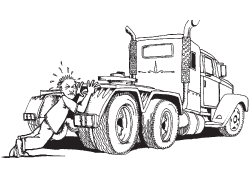Newton’s
First law of motion
Newton’s first law states that an object in motion
will stay in motion until acted on by an outside force, or that an object at
rest will stay at rest until acted on by an outside force. This is a concept
that cannot be displayed on earth as there are always outside forces acting on
the objects. The most common forces are wind, gravity, friction, etc. The place
where this concept can be see first-hand is in space. It would be quite amazing
to throw a ball in space and never see it slow down.

Net
Force
Net force is the total of the forces
acting on an object. The amount of force that is placed on an object is
measured in Newtons abbreviated (N). As an example if someone is pushing a box
to the left with 10N of force, the net force of the box is 10N. If another
person comes by and applies 10N of force to the right side of the box then the
forces are subtracted from each other to find the net force. In this case
10-10=0, 0N in the net force of the box. Say another person walks by and adds
20N of force to the left side of the box, then the forces from each side of the
box are subtracted. In this case 20+10=30N is the force on the right side of
the box. The left side still only has 10N of force. So 30-10=20N of force is
the net force of the box. Only the force that is applied opposite to the other
force is able to be subtracted.
 Equilibrium
Equilibrium
Equilibrium is the special case where the net force
of the object is 0N. At equilibrium the object can be at rest, in motion, or at
rest in motion. At equilibrium the objects forces are balanced and the object
can be at constant velocity or constant acceleration.
Velocity
Velocity is the speed that something travels. It is speed and the direction, it is NOT the same as speed. Velocity is normally measured in meters per
second, abbreviated m/s. But velocity can also be measured in other increments
as long as it is the measure unit of a distance over the time as in cm/s, mi/h,
km/min, etc. When the velocity of the object remains the same it is referred to
as constant velocity. Constant velocity has two formulas associated with it,
these formulas only work for constant velocity. The first is to determine the
velocity of the object is velocity=distance divided by time (v=d/t). The other
is for finding the distance something has traveled at constant velocity it is
distance =velocity multiplied by time (d=vt).
Acceleration
The acceleration of an object is the change in
velocity in a period of time. Acceleration is measured by meters per second per
second abbreviated m/s². Acceleration is not only forward it is also in
reverse, when a car slows down it is accelerating in the opposite direction.
Acceleration can be changing by either slowing down or speeding up, but when it
stays at a constant there are two formulas that accompany constant
acceleration. To find the velocity of an object a constant acceleration the
formula is velocity =acceleration multiplied by time (v=at). The formula for
the distance at a constant acceleration is the distance=one half multiplied by
the acceleration multiplied by the time squared (d=1/2at²).
Using
the graph
The graph equation y=mx+b is used in physics. It is
mostly used in constant velocity and constant acceleration. The majority of the
time the b value is about equal to 0, and all that remains is the y=mx. In the
case for constant velocity the y=mx translates to d=vt, the slope m by itself
translates to m=d/t. For constant acceleration the y=mx translates to d=1/2at²,
the slope m itself translates to m=1/2a. The slopes of the graphs are very
useful to find the velocity and the acceleration.
No comments:
Post a Comment